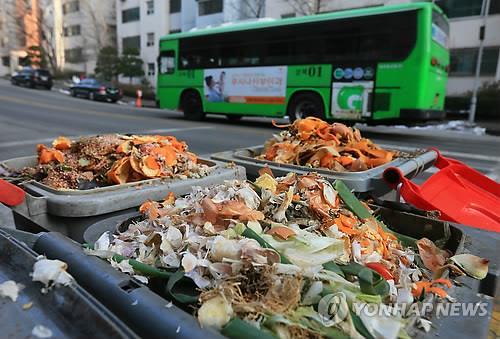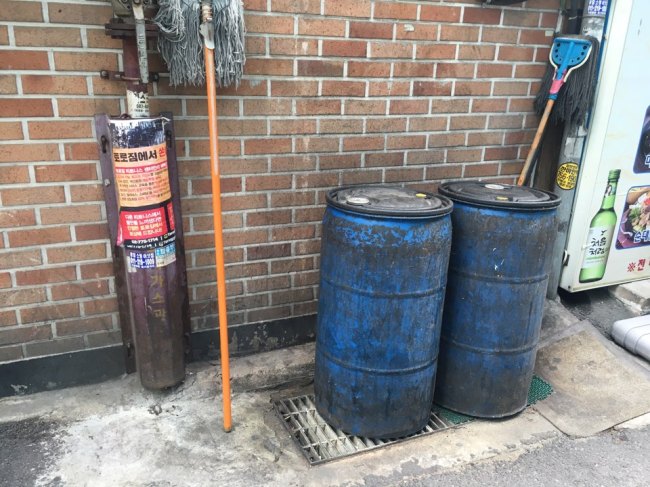[FEATURE] Seoul struggles to stamp out bad summer smells
Malodor is a major type of pollution here, with authorities struggling to provide a concrete solution
By Kim Da-solPublished : Aug. 18, 2016 - 16:47
This is the first installment of a three-part series on Seoul’s battle against three types of urban pollution: smell, noise and light. --Ed.
For Kim Ok-jin, 56, summer is the season of the year when her anxiety peaks, especially when she tries to open her windows.
Her main concern is not the scorching weather, but the food smell that wafts over to her house from a “galbi” (Korean barbequed ribs) restaurant across the street.
Kim has been living in Seoul’s southeastern town Jamsil in Songpa-gu for about five decades.
Smell and smoke from grilling pork invade her house day and night. A giant plastic container filled with food waste is also placed outside overnight, stinking up the entire street.
“I have tried telling the restaurant owner about the malodor pollution. I also called Songpa-gu Office and filed a civil complaint,” Kim said.
For Kim Ok-jin, 56, summer is the season of the year when her anxiety peaks, especially when she tries to open her windows.
Her main concern is not the scorching weather, but the food smell that wafts over to her house from a “galbi” (Korean barbequed ribs) restaurant across the street.
Kim has been living in Seoul’s southeastern town Jamsil in Songpa-gu for about five decades.
Smell and smoke from grilling pork invade her house day and night. A giant plastic container filled with food waste is also placed outside overnight, stinking up the entire street.
“I have tried telling the restaurant owner about the malodor pollution. I also called Songpa-gu Office and filed a civil complaint,” Kim said.

“District office officials came back to me with ridiculous answers. They told me that malodor pollution does not provide a legal basis for officials to intervene and control,” she added.
This summer, Kim has resorted to turning on two air purifiers inside her house 24/7, adding to her electricity bill.
Malodor is a major bugbear in metropolitan cities during summer and it is considered a major form of pollution, along with light and noise.
The scorching heat of summer volatilizes malodor caused from materials such as food waste, leading to serious sanitary problems, city officials explained.

Malodor not only stimulates the olfactory sense, but also can have an impact on the respiratory system, mucous membrane and eyes, potentially leading to a headache, nausea, loss of appetite and higher stress levels.
According to the Seoul Metropolitan Government, the number of civil complaints on malodor hit 4,022 last year, more than four times higher than the 957 complaints in 2009.
By district, Songpa-gu had the highest number of civil complaints on malodor, followed by Dongdaemun-gu and Gangnam-gu. All three districts are known to have popular food alleys and a large floating population.
District officials say that although the odor sometimes reaches intolerable levels in food alleys during summer, it is hard for them to crack down on it.
“When we receive civil complaints on malodor from a restaurant, we send an enforcement notice to the restaurant owner. If they fail to provide a solution for the third consecutive time, we levy them with a 200,000 won penalty,” said an official from Songpa-gu office.
Current law states that facilities that emit malodor can pay “all or part of costs necessary for the operation of public malodor treatment facilities.”
In 2003, the government enacted the Malodor Prevention Act and defined malodor as “any odor that causes displeasure and disgust to people by stimulating their olfactory sense with hydrogen sulfide, mercaptane, amine, or other pungent substances.”
It was made to ensure that citizens can “live in a healthy and pleasant environment by preventing malodor produced due to business activities,” but the act only states that it applies to large-scale businesses or factories.
Authorities dispatched to sites to settle civil complaints also face difficulties.
“We also feel difficulty providing solution to malodors since we have no malodor detecting device. As we are not professionals or experts, all we can do is to give warnings to malodor-emitting facilities,” said a district office official.
Experts say it is difficult to define the exact cause of malodors since they are invisible. The severity of malodors also varies per person.
For now, it is important to develop a detailed plan to find the causes of malodors and prevent them, said experts.
“It is necessary to plan out a customized management system on controlling malodor, since there are a variety of smells and origins such as drain pipes, factories and restaurants,” said Kim Young-doo from the Public Health and Environment Research Institute under Seoul City.
"We are planning to provide a consulting program and facility renovations such as improving sewage system and food waste disposals,” he added.
The SMG earlier this month vowed to inject 170 million won ($153,561) to install more malodor reduction devices, aiming to lower the number of civil complaints on malodor by 30 percent by 2018.
Malodor reduction devices, similar to an air purification system, works by injecting a certain amount of oxygen to prevent gas stored inside septic tanks from being released as malodor through manholes or inlets on streets.
It costs approximately 2 million won to install such a device in a five-story building.
It will also conduct random inspections at some waste landfills and septic tanks operators to make sure they meet waste exhaust standards.
The city government said that it has so far installed over 1,000 malodor reduction devices at septic tanks and removed 980 rainwater pipes from bus stops and crosswalks near pedestrian roads. It also carries out regular cleaning of drains every year.
By Kim Da-sol(ddd@heraldcorp.com)



![[Exclusive] Korean military set to ban iPhones over 'security' concerns](http://res.heraldm.com/phpwas/restmb_idxmake.php?idx=644&simg=/content/image/2024/04/23/20240423050599_0.jpg&u=20240423183955)
![[AtoZ into Korean mind] Humor in Korea: Navigating the line between what's funny and not](http://res.heraldm.com/phpwas/restmb_idxmake.php?idx=644&simg=/content/image/2024/04/22/20240422050642_0.jpg&u=)




![[Graphic News] 77% of young Koreans still financially dependent](http://res.heraldm.com/phpwas/restmb_idxmake.php?idx=644&simg=/content/image/2024/04/22/20240422050762_0.gif&u=)
![[Herald Interview] Why Toss invited hackers to penetrate its system](http://res.heraldm.com/phpwas/restmb_idxmake.php?idx=644&simg=/content/image/2024/04/22/20240422050569_0.jpg&u=20240422150649)





![[Exclusive] Korean military to ban iPhones over security issues](http://res.heraldm.com/phpwas/restmb_idxmake.php?idx=652&simg=/content/image/2024/04/23/20240423050599_0.jpg&u=20240423183955)



![[Today’s K-pop] Ateez confirms US tour details](http://res.heraldm.com/phpwas/restmb_idxmake.php?idx=642&simg=/content/image/2024/04/23/20240423050700_0.jpg&u=)